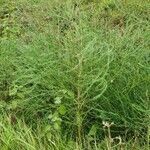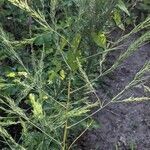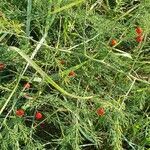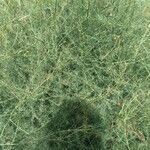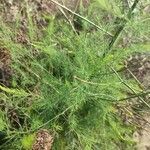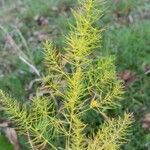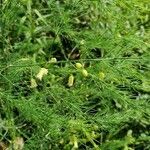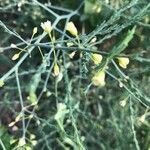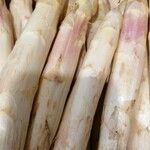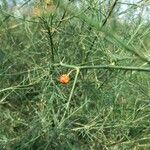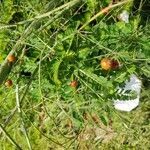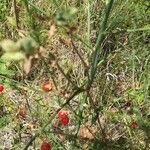Herbs dioecious. Roots 2--3 mm thick, rather slender. Stems suberect, to 1 m, usually slightly pendent apically; branches soft. Cladodes in fascicles of 3--6, 0.5--3 cm × ca. 0.4 mm, subterete, slightly flattened, irregularly grooved. Leaf spur slightly spinescent or indistinct. Inflorescences developing after cladodes. Flowers of both sexes solitary of in clusters of 2--4; pedicel 0.8--1.2(--1.4) cm. Male flowers: perianth yellowish green, campanulate, 5--6 mm; filaments adnate to perianth segments for ca. 1/2 their length; anthers 1--1.5 mm. Female flowers: perianth ca. 3 mm. Berry red, 7--8 mm in diam., 2-or 3-seeded. Fl. May--Jun, fr. Aug. 2 n = 20*, 40.
Summer-green dioecious perennial, with woody crown; roots long, cylindrical, fleshy. Stems 60-120 cm high, bright green, stiffly erect, ± woody below, branched above; shoots fleshy, edible. Scale-leaves scarious, 1-5 mm long, with short soft basal spur. Cladodes needle-like, 5-15 mm long, 2-8 at each node. Flowers axillary, 1-2-(4), greenish-yellow; pedicels drooping, 5-10 mm long; male flowers 5-6 mm long, stamens ± 3 mm long, ovary rudimentary; female flowers shorter, ± 4 mm long, stamens ± 1.5 mm long, functionless. Berry globose, ± 6-8 mm diam., red. Seeds 1-9, ± 3 mm diam., black.
Herbs, erect, 1–2.5 m; rhizomes fibrous. Stems annual, densely branched distally; branches finely dissected, ascending to perpendicular, unarmed; cladophylls in clusters of (2–)4–15(–25) per node, filiform, straight or curved, 1–3 cm. Leaves scalelike, 3–4 mm; blade lanceolate, base hardened. Inflorescences in axillary racemes, 1–3-flowered. Flowers some unisexual; perianth campanulate, yellow or yellowish green; tepals connate 1–2 mm, greenish white, 3–8 × 1–2 mm; pedicel 8–12 mm, jointed at or above middle. Berries red, 6–10 mm. Seeds 2–4. 2n = 20, 40.
A herb. A perennial plant with leaves like a feather and an underground root stock. It grows to 1.5 m high and spreads to 1 m across. The stems are erect but often hang over at the tips. The branches are soft. The leaves are feathery and a rich green colour. The flowers are small and greenish. They are of both sexes and occur either singly or in clusters of 2-4. The fruit are red berries. They are produced on female plants. They are 7-8 mm across. There are 2 or 3 seeds.
Perennial from a short rhizome, freely branched, to 2 m; ultimate branchlets filiform, 8–15 mm; pedicels solitary or paired, lateral, 5–10 mm, jointed at the middle; fls greenish-white, campanulate, 3–5 mm; berry red, 8 mm; 2n=20, 40. Native of Europe, escaped from cult. into waste places or along salt marshes. May, June.
